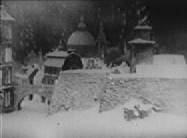
“La Petite Marchande D’Allumettes” ( The Little Match Girl ) was directed in 1928 by the great but frenchified film director, Jean Renoir and is based on the homonymous and one of the cruellest stories ever written for children, proletarians or aristocrats alike( this German Count remembers very well even today the stormy night when the nanny told this aristocrat that sadistic story…) and is from the pen of the Danish writer Hans Christian Andersen. Fortunately Herr Renoir is a more civilized ( despite being French… ) person and softens the story about of the little match girl ( well… Damen Catherine Hessling is pretty old for such role… ) who grows stiff with cold on a snowy night.
The film has beautiful sets that enhance the atmosphere and spirit of the classic fairy tale, especially the playroom, full of amazing toys that every child in the world would wish.
The director manipulates the backgrounds and sizes of the different toys so that they can be alternately playful or threatening. The dream sequence in which the little match girl flees on a horse to the clouds with her toy soldier is a remarkable, thrilling and poetic sequence with astonishing editing is full of many, different angles up and down giving the scene a very fluid feel. Of course it all finishes in a terrible way for the little match girl but thanks to the Herr Renoir mastery it’s a beautiful ending with a moving lyrical feeling.
Only 30 minutes are enough for Herr Jean Renoir to create an exceptional film adaptation, classical and evocative and which more than overcomes Herr Andersen harsh intentions.
And now, if you'll allow me, I must temporarily take my leave because this German Count must order his servants never again ignite the chimney with matches.
Herr Graf Ferdinand Von Galitzien
-/-
“La Petite Marchande D’Allumettes” es un filme dirigido por el gran director afrancesado Jean Renoir, una película basada en la homónima y una de las historias más crueles escritas para infantes, proletarios o aristócratas ( este conde germánico aún recuerda perfectamente la tormentosa noche en la cual la niñera contó a ése aristócrata esa sádica historia… ) escrita por el escritor danés Hans Christian Andersen; afortunadamente Herr Renoir es una persona, a pesar de ser francés…, civilizada y poetiza la historia de la pequeña cerillera ( aunque la verdad, Damen Catherine Hessling está un poco mayor para dicho papel… ) que muere de frío durante una noche nevosa.
El filme tiene bellos decorados que atrapan la atmósfera y espíritu de los cuentos de hadas clásicos, especialmente la sala de juegos, repleta de juguetes sorprendentes que cualquier niño en el mundo desearía tener; el director manipula escenario y proporciones de los diferentes juguetes para que éstos pueden parecer amenazantes o encantadores; a destacar también la escena del sueño en la cual la protagonista huye a caballo por las nubes con su soldadito de plomo, excelente secuencia, trepidante y poética con un sorprendente montaje repleto de diferentes tomas desde diferentes ángulos, consiguiendo una escena fluida y emocionante.
Por supuesto que en el filme todo finaliza de forma terrible para la pequeña cerillera pero gracias a la maestría de Herr Renoir, la obra posee un bello final con un conmovedor sentimiento poético.
30 minutos bastan para que Herr Jean Renoir cree una excepcional adaptación cinematográfica, clásica y emotiva que, afortunadamente, matiza las crueles intenciones originales de Herr Andersen.
Y ahora si me lo permiten les tengo que dejar momentáneamente, pues este Conde germánico tiene que ordenar a sus sirvientes que jamás vuelvan a encender la chimenea con cerillas.
Herr Graf Ferdinand Von Galitzien

1 Kommentar:
I always thought you guys had humanitarian and civilizational reasons to invade Denmark and France, bless you for reminding me of them....can't imagine
what the hell happened to people's sense of style.
As for the film stilistically it just hints at the great expressionist master Renoir would become later (with talkies) following in the footsteps of those renowned germans who left for the states because perhaps they couldn't all be Leni Riefenstahl (a remarkable film maker despite being german and a bit of a nazi).
Kommentar veröffentlichen